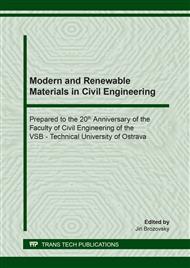[1]
J. Strasky, J. Navratil, S. Susky, Applications of time-dependent analysis in the design of hybrid bridge structures (2001). PCI Journal, 46 (4), pp.56-74, ISSN 08879672.
DOI: 10.15554/pcij.07012001.56.74
Google Scholar
[2]
J. Navratil, Structural analysis of bridges, legitimate conservatism and obsolete theories (2004). Concrete Engineering International, 8 (1), pp.17-19, ISSN 14605856.
Google Scholar
[3]
J. Navratil, M. Zich, Long-term deflections of cantilever segmental bridges (2013). Baltic Journal of Road and Bridge Engineering, Volume 8, Issue 3, pages 190-195. ISSN: 1822427X,.
DOI: 10.3846/bjrbe.2013.24
Google Scholar
[4]
P. Pazma, V. Borzovic, J. Halvonik, Secondary effects of prestressing at ULS on hyperstatic structures (2016). Key Engineering Materials, 691, pp.138-147.
DOI: 10.4028/www.scientific.net/KEM.691.138
Google Scholar
[5]
J. Halvonik, J. Dolnak, V. Borzovic, Long-term losses of prestress in precast members cast from HPC (2013). Procedia Engineering, 65, pp.81-86.
DOI: 10.1016/j.proeng.2013.09.015
Google Scholar
[6]
J. Nesvara, Assessing Instrumentation and Measurement of Foundation Plate and Subsoil in Experimental Rack Hall of Ostrava – Vítkovice, part 1 to 6, Geotest Brno, 1986 to 1988 (in Czech).
Google Scholar
[7]
P. Mynarcik, R. Cajka, Experimental testing of post-tensioned concrete industrial floor model - subsidence analysis (2016), International Journal of Mechanics, 10, pp.33-38.
Google Scholar
[8]
R. Cajka, P. Mynarcik, J. Labudkova, (2016). Experimetal measurement of soil-prestressed foundation interaction, International Journal of GEOMATE, 10 (4), pp.2101-2108.
DOI: 10.21660/2016.22.5385
Google Scholar
[9]
J. Labudkova, R. Cajka, Comparing the rigidity of the prestressed and non-prestressed foundation (2016). Jurnal Teknologi, 78 (5-2), pp.111-116,.
DOI: 10.11113/jt.v78.8500
Google Scholar
[10]
P. Mynarcik, J. Labudkova, J. Koktan, Experimental and numerical analysis of interaction between subsoil and post-tensioned slab on ground (2016). Jurnal Teknologi, 78 (5-4), pp.23-27.
DOI: 10.11113/jt.v78.8530
Google Scholar
[11]
V. Kolar, J. Kratochvil, F. Leitner, A. Zenisek, Berechnung von Flachen- und Raumtragwerken nach der Methode der finiten Elemente (1975). Springer-Verlag Wien, New York.
Google Scholar
[12]
R. Sonnenschein, J. Bilcik, K. Gajdosova, Parameter analysis of the reinforcement for the width and spacing control of the early-age cracks in concrete (2016). Key Engineering Materials, 691, pp.14-27.
DOI: 10.4028/www.scientific.net/KEM.691.14
Google Scholar
[13]
M. Ignacak, J. Soltesz, I. Prcuch, Thermal and Strength analysis of foundation slabs, industrial floors and cement covers of road pavements in the early stages (2013). Procedia Engineering, 65, pp.94-99.
DOI: 10.1016/j.proeng.2013.09.017
Google Scholar
[14]
J. Soltesz, M. Ignacak, K. Gajdosova, Design of the foundation structures and interaction with the subsoil (2014). International Multidisciplinary Scientific GeoConference Surveying Geology and Mining Ecology Management, SGEM, 2 (1), pp.283-290.
DOI: 10.5593/sgem2014/b12/s2.037
Google Scholar
[15]
M. Ignacak, J. Soltesz, Influence of the different factors on formation of cracks on the foundation slabs, concrete pavements and industrial floors at an early stage - Parametric study (2016). Key Engineering Materials, 691, pp.129-137.
DOI: 10.4028/www.scientific.net/KEM.691.129
Google Scholar
[16]
L. Fillo, T. Augustin, V. Knapcova, J. Labudkova, Punching resistance verification of footings (2016). International Multidisciplinary Scientific GeoConference Surveying Geology and Mining Ecology Management, SGEM, 249, pp.179-184.
DOI: 10.4028/www.scientific.net/SSP.249.179
Google Scholar
[17]
H. Lahuta, E. Hrubesova, L. Duris, T. Petrasova, Behaviour subsoil of slab foundation under loading (2015). International Multidisciplinary Scientific GeoConference Surveying Geology and Mining Ecology Management, SGEM, 2 (1), pp.119-126.
DOI: 10.5593/sgem2015/b12/s2.016
Google Scholar
[18]
M. Mohyla, K. Vojtasik, E. Hrubesova, M. Stolarik, M. Pinka, The optimalization of pressure cell installation via numerical simulation (2016). International Multidisciplinary Scientific GeoConference Surveying Geology and Mining Ecology Management, SGEM, 1, pp.1029-1036.
DOI: 10.5593/SGEM2016/B11/S02.130
Google Scholar
[19]
E. Hrubesova, H. Lahuta, L. Duris, M. Jaafar, Mathematical modeling of foundation-subsoil interaction (2015). International Multidisciplinary Scientific GeoConference Surveying Geology and Mining Ecology Management, SGEM, 2 (1), pp.437-444.
DOI: 10.5593/sgem2015/b12/s2.058
Google Scholar
[20]
R. Cajka, V. Krivy, D. Sekanina, Design and development of a testing device for experimental measurements of foundation slabs on the subsoil (2011). Transactions of the VŠB – Technical University of Ostrava, Civil Engineering Series, 11 (1), 1 - 5, ISSN (Online) 1804-4824, ISSN (Print) 1213-1962,.
DOI: 10.2478/v10160-011-0002-2
Google Scholar
[21]
P. Mynarcik, Measurement processes and destructive testing of fiber concrete foundation slab pattern (2014). Advanced Materials Research, 1020, pp.221-226,.
DOI: 10.4028/www.scientific.net/AMR.1020.221
Google Scholar
[22]
M. Janulikova, The New Options to Reduce Shear Stress into Foundation Structure (2015). Procedia Engineering, 114, pp.514-521,.
DOI: 10.1016/j.proeng.2015.08.100
Google Scholar
[23]
M. Janulikova, M. Stara, P. Mynarcik, Sliding joints from traditional asphalt belts (2014). Advanced Materials Research, 1020, pp.335-340,.
DOI: 10.4028/www.scientific.net/amr.1020.335
Google Scholar
[24]
M. Janulikova, Behavior of selected materials to create sliding joint in the foundation structure (2014). Advanced Materials Research, 838-841, pp.454-457,.
DOI: 10.4028/www.scientific.net/AMR.838-841.454
Google Scholar
[25]
M. Janulikova, Comparison of the shear resistance in the sliding joint between asphalt belts and modern PVC foils (2014). Applied Mechanics and Materials, 501-504, pp.945-948,.
DOI: 10.4028/www.scientific.net/AMM.501-504.945
Google Scholar
[26]
R. Cajka, Analytical derivation of friction parameters for FEM calculation of the state of stress in foundation structures on undermined territories (2013). Acta Montanistica Slovaca, Volume 18, Issue 4, Pages 254-261, ISSN: 13351788.
Google Scholar
[27]
E.D.L. Pugh, E. Hinton, O.C. Zienkiewicz, A study of quadrilateral plate bending elements with reduced, integration (1978), International Journal for numerical Methods in Engineering, 12, pp.1059-1079.
DOI: 10.1002/nme.1620120702
Google Scholar
[28]
T.J.R. Hughes, M. Cohen, M. Haroun, Reduced and selective integration techniques in the finite element analysis of plates (1978). Nuclear Engineering and Design, 46, pp.203-222.
DOI: 10.1016/0029-5493(78)90184-x
Google Scholar
[29]
Cajka, R., Analysis of Stress in Half-Space using Jacobian of Transformation and Gauss Numerical Integration (2013). Advanced Materials Research, 818, 178-186. DOI:10.4028 /www.scientific.net/ AMR.818.178.
DOI: 10.4028/www.scientific.net/amr.818.178
Google Scholar
[30]
R. Cajka, Accuracy of stress analysis using numerical integration of elastic half-space (2013). Applied Mechanics and Materials, 300-301, 1127-1135.
DOI: 10.4028/www.scientific.net/AMM.300-301.1127
Google Scholar
[31]
J. Labudkova, R. Cajka, Comparison of the Results from Analysis of Nonlinear Homogeneous and Nonlinear Inhomogeneous Half-Space (2015), Procedia Engineering, 114, pp.522-529,.
DOI: 10.1016/j.proeng.2015.08.101
Google Scholar
[32]
R. Cajka, J. Labudkova, P. Mynarcik, Numerical solution of soil - foundation interaction and comparison of results with experimental measurements (2016), International Journal of GEOMATE, 11 (1), pp.2116-2122.
Google Scholar
[33]
R. Cajka, J. Labudkova, Finite element analyses of soil-foundation interaction and comparison with experimental measurements (2015), Civil-Comp Proceedings, 108,.
DOI: 10.4203/ccp.108.7
Google Scholar


